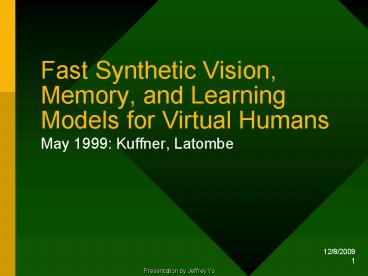Fast Synthetic Vision, Memory, and Learning Models for Virtual Humans - PowerPoint PPT Presentation
1 / 16
Title:
Fast Synthetic Vision, Memory, and Learning Models for Virtual Humans
Description:
If an object moves and is observed at its new position, update the ... Example: object1 and object2 are joined, so observing one implies the other is nearby. ... – PowerPoint PPT presentation
Number of Views:38
Avg rating:3.0/5.0
Title: Fast Synthetic Vision, Memory, and Learning Models for Virtual Humans
1
Fast Synthetic Vision, Memory, and Learning
Models for Virtual Humans
- May 1999 Kuffner, Latombe
Presentation by Jeffrey Yu
2
Goal Autonomous Characters in a Virtual World
3
Primitive Framework
4
Proposed Framework
- New components synthetic vision, character
memory - Motivation realism, efficiency
5
Fast Synthetic Vision V
6
POV Image Pairs
7
Basic Sense-plan-control Loop
8
Character Memory M
- Set of observations
- Incremental construction
- Updated once per sensing cycle
- Observations include
- Unique object-id
- Object position, orientation, and velocity
- Observation time
- Additional object properties as needed
9
Memory Update Rules
- Object appearance
- If an object is observed but is not in the
memory, add the observation to the memory - Object movement
- If an object moves and is observed at its new
position, update the observation of the object in
the memory
- Object disappearance
- If an object moves and its former position is
observed first, remove the observation of the
object from the memory
10
Object Appearance
11
Object Movement and Disappearance
12
Problem Case Obscured Objects
- Solution
- Run vision module on M to find VM, the set of
objects expected to be visible - Remove from M only the objects in VM that are not
in V
13
Revised Sense-plan-control Loop
14
Enhanced Memory Models
- May contain elements of
- Forgetfulness. Example observations fade with
time to reduce processing load. - Prediction. Example observations change based
on object velocity and time. - Logic. Example object1 and object2 are joined,
so observing one implies the other is nearby.
15
(No Transcript)
16
Conclusions
- A simple model of visual perception, memory, and
learning in autonomous characters is feasible for
real-time interactive applications - Such a model can be combined with higher-level
reasoning modules or complex memory rules - Current processing bottleneck is the synthetic
vision component (question what type of path
planner was used?)






























